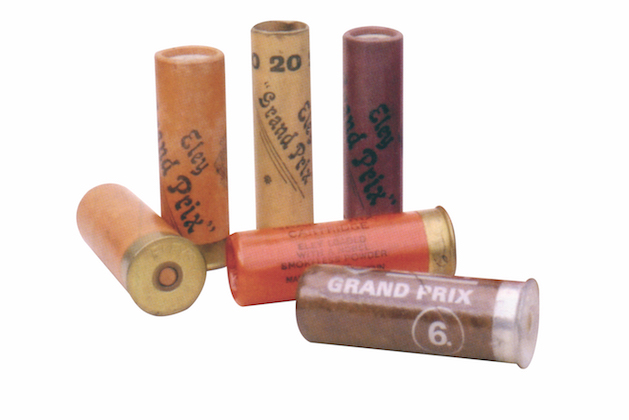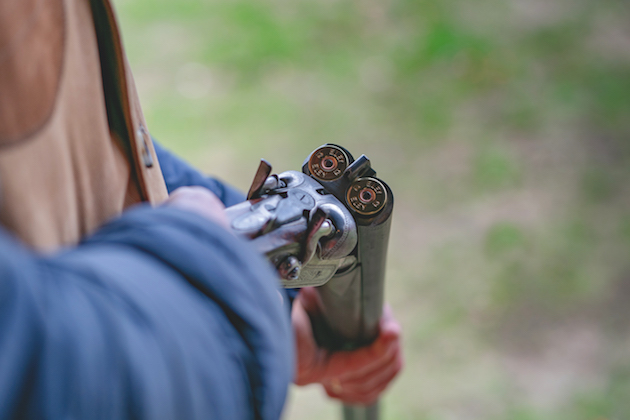A short history of the shotgun
A very long time ago, some enterprising person decided to fill a tube with gunpowder, put a rock or something…
Win CENS ProFlex DX5 earplugs worth £1,149 – enter here

I am going to concentrate on shotgun cartridge history and how it got to be what it is today — the cheap, waterproof, reliable, effective, safe and consistent item on which we all rely to deliver success, whatever target we engage. After all, a gun, however expensive and sophisticated, is only as good as the ammunition you put into it.
Early cartridges were brass but from the mid-1870s paper cases became more common. Until the 1930s, paper-case, brass-case and combination cartridges were widely marketed. As it was water-resistant, brass was popular with wildfowlers. Thinner walled, it offered benefits by requiring less of a step from chamber to bore, resulting in the ‘chamberless gun’ concept that was influential for a while. Brass was also favoured by re-loaders, as the cases were longer-lived.
In 1903, Eley launched the paper-cased Grand Prix, which would be the benchmark for British shotgun cartridges for the next 80 years. To repel damp, paper cases were varnished. Convenient as they were, however, early 20th-century cartridges still had faults. A cartridge extractor was an essential part of your shooting kit in case you had to remove a stuck case, manually, in the field.
The other problem was corrosive primers. The fulminate used to generate ignition was aggressive in attacking the steel in the barrels and the breech face, with pitting the inevitable result unless the gun was cleaned carefully after every outing. This problem was not solved until the late 1950s.
Waterproofing paper hulls was quite effective by 1895, when Eley produced the Pegamoid case — five layers of paper, bonded with water-resistant adhesive. Remington introduced plastic cases in the 1960s and Eley started selling a plastic-cased version of the Grand Prix in 1974. They quickly overtook paper cases in sales, offering better waterproofing and no tendency to swell when damp.
Macdonald Hastings, writing in 1981, reflected on the downside of these new waterproof cartridges as “currently criticised because the plastic cases have been found to be as indestructible as the flint arrowheads of our Stone Age ancestors.
“Landowners object to the detritus of expended cartridges. Currently, the aim is to produce a cartridge that is weather-resistant and which will dissolve into the soil. It is probably very near.”

Ammunition has never been better or cheaper
Almost 40 years later, we are still waiting for that fully degradable plastic case. Originally, cases were closed with an over-shot card and a rolled turnover of the paper case. This over-shot card could interfere with the shot string and intermittent ‘cartwheel’ patterns with large holes in them were the result. With the advent of the modern crimp closure, this problem disappeared.
As the container and means of ignition improved, so too did the components inside. Blackpowder of different grades gave way to the new ‘smokeless’ powders during the last decade of the 19th century, with Schultze, E.C. Powder and others jockeying for favour at a time when most gunmakers still hand-loaded huge numbers of cartridges for their customers. Specialist manufacturers industrialised the process and took over the business entirely.
Shot was perfected as early as 1782, when William Watts developed the idea of drop-shot, which involves pouring molten lead through a sieve and allowing the drops to fall from a tower, hardening into perfect spheres as they do so. Hardness is regulated by the addition of antimony.
Today, we have copper-coated shot, as well as non-toxic alternatives to lead.
Between powder and shot, the wad has changed over the years. Two thin felt wads with cork between them was used by some manufacturers, vegetable fibre, paper pulp and all kinds of materials have been tried. Typically, a pre-war wad would be made of elastic and dense, greased felt, with card glued to either end.
In the mid-19th century, gunmakers experimented with different wads and shot cups. Greener describes a ‘Swedish cup wad’, for use with the then novel nitro powders, which had a conical base and was made of paper pulp. It protected the shot and produced tighter patterns. Some used wire cages to hold the shot together for longer in flight.
The role of the wad is to block the burning gases sufficiently to stop them melting the shot, making it ‘ball’, and provide cushioning to minimise deformation to the lower layers of shot as the shot column is forced forward. It also forces out the fouling in the bore from the previous shot. Eley made a marketing virtue of this with its Kleena wad, constructed from vegetable fibre.
While fibre wads are still insisted upon by many shoots, the one-piece cushioned wad and shot cup found in many high-performance cartridges is the highest point of wad development to date. Like plastic shell cases, it creates the problem of indestructibility and littering. Efforts to produce a robust plastic wad that degrades quickly look promising and I hope we will see an end to non-degradable plastic wads soon.
The pressure to make cartridges shoot further and hit harder has been with ammunition makers forever. It is interesting to see the modern fad for super-fast muzzle velocities in the light of the experiments carried out by Burrard and others. Greener, Burrard and Purdey all concluded that driving the load very fast did not achieve any real benefit down-range.
Long-range shooting with larger shot is most effectively achieved by using low-velocity loads, generating momentum, which is maintained down-range without blowing the pattern. A muzzle velocity of 1,320fps was generally thought best, yet there seems to be a fad for cartridges now that achieve more than 1,450fps.
A very long time ago, some enterprising person decided to fill a tube with gunpowder, put a rock or something…
For all the good it could do you might as well hammer the barrels into the ground and use it as…
The different parts of a shotgun cartridge explained
Finally, there is the matter of cost.
In the 1930s, the Midland Gun Co. sold the Demon Waterproof cartridge for 16 shillings per 100.
Holland & Holland sold 100 Best, brass-lined, Royal cartridges for 21 shillings.
A new Royal hammerless ejector shotgun cost £120. Put that into perspective: a new Best gun cost 120 times the cost of 100 cartridges. Today, a Royal costs £120,000. Can you name a brand of cartridge that costs £1,000 per 100? Neither can I. Think about that next time the chap in the Gun bus next to you starts moaning about the cost of ammunition.
The comparison is not quite fair, as the cost of Best guns has increased enormously out of proportion to everything else.
However, even using standard indexing criteria, 21 shillings in 1935 amounts to £70 per 100 cartridges today, or £700 per 1,000, which is still more than twice what we pay.
If we relate the price to average earnings, those cartridges would cost you £1,900 per 1,000 now.
The fact is, whichever way you look at it, ammunition has never been better and it has never been cheaper.
Get the latest news delivered direct to your door
Discover the ultimate companion for field sports enthusiasts with Shooting Times & Country Magazine, the UK’s leading weekly publication that has been at the forefront of shooting culture since 1882. Subscribers gain access to expert tips, comprehensive gear reviews, seasonal advice and a vibrant community of like-minded shooters.
Save on shop price when you subscribe with weekly issues featuring in-depth articles on gundog training, exclusive member offers and access to the digital back issue library. A Shooting Times & Country subscription is more than a magazine, don’t just read about the countryside; immerse yourself in its most authoritative and engaging publication.

